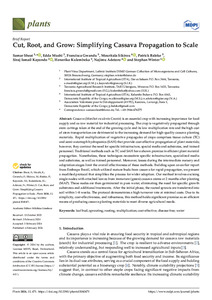| dc.contributor.author | Sheat, S. |
| dc.contributor.author | Mushi, E. |
| dc.contributor.author | Gwandu, F. |
| dc.contributor.author | Sikirou, M. |
| dc.contributor.author | Bakele, P. |
| dc.contributor.author | Kayondo, S.I. |
| dc.contributor.author | Kulembeka, H. |
| dc.contributor.author | Adetoro, N. |
| dc.contributor.author | Winter, S. |
| dc.date.accessioned | 2024-04-08T10:42:35Z |
| dc.date.available | 2024-04-08T10:42:35Z |
| dc.date.issued | 2024-02-06 |
| dc.identifier.citation | Sheat, S., Mushi, E., Gwandu, F., Sikirou, M., Baleke, P., Kayondo, S.I., ... & Winter, S. (2024). Cut, root, and grow: simplifying cassava propagation to scale. Plants, 13(4): 471, 1-11. |
| dc.identifier.issn | 2223-7747 |
| dc.identifier.uri | https://hdl.handle.net/20.500.12478/8464 |
| dc.description.abstract | Cassava (Manihot esculenta Crantz) is an essential crop with increasing importance for food supply and as raw material for industrial processing. The crop is vegetatively propagated through stem cuttings taken at the end of the growing cycle and its low multiplication rate and the high cost of stem transportation are detrimental to the increasing demand for high-quality cassava planting materials. Rapid multiplication of vegetative propagules of crops comprises tissue culture (TC) and semi-autotroph hydroponics (SAH) that provide cost-effective propagation of plant materials; however, they contrast the need for specific infrastructure, special media and substrates, and trained personnel. Traditional methods such as TC and SAH have shown promise in efficient plant material propagation. Nonetheless, these techniques necessitate specific infrastructure, specialized media
and substrates, as well as trained personnel. Moreover, losses during the intermediate nursery and adaptation stages limit the overall effectiveness of these methods. Building upon an earlier report from Embrapa Brazil, which utilized mature buds from cassava for rapid propagation, we present a modified protocol that simplifies the process for wider adoption. Our method involves excising single nodes with attached leaves from immature (green) cassava stems at 2 months after planting (MAP). These nodes are then germinated in pure water, eliminating the need for specific growth substrates and additional treatments. After the initial phase, the rooted sprouts are transferred into soil within 1–8 weeks. The protocol demonstrates a high turnover rate at minimal costs. Due to its simplicity, cost-effectiveness, and robustness, this method holds significant promise as an efficient
means of producing cassava planting materials to meet diverse agricultural needs. |
| dc.description.sponsorship | Bill & Melinda Gates Foundation |
| dc.format.extent | 1-11 |
| dc.language.iso | en |
| dc.subject | Cassava |
| dc.subject | Manihot Esculenta |
| dc.subject | Food Supply |
| dc.subject | Plant Propagation |
| dc.subject | Hydroponics |
| dc.subject | Leaf Buds |
| dc.subject | Sprouting |
| dc.subject | Rooting |
| dc.title | Cut, root, and grow: simplifying cassava propagation to scale |
| dc.type | Journal Article |
| cg.contributor.crp | Roots, Tubers and Bananas |
| cg.contributor.affiliation | Leibniz Institute DSMZ-German Collection of Microorganisms and Cell Cultures |
| cg.contributor.affiliation | International Institute of Tropical Agriculture |
| cg.contributor.affiliation | Tanzania Agricultural Research Institute |
| cg.contributor.affiliation | Association Volontaire pour le Développement, Democratic Republic of the Congo |
| cg.coverage.region | Africa |
| cg.coverage.region | Central Africa |
| cg.coverage.region | East Africa |
| cg.coverage.country | Democratic Republic of the Congo |
| cg.coverage.country | Tanzania |
| cg.coverage.hub | Eastern Africa Hub |
| cg.coverage.hub | Central Africa Hub |
| cg.researchtheme | Biotech and Plant Breeding |
| cg.isijournal | ISI Journal |
| cg.authorship.types | CGIAR and developing country institute |
| cg.iitasubject | Agronomy |
| cg.iitasubject | Cassava |
| cg.iitasubject | Food Security |
| cg.iitasubject | Plant Breeding |
| cg.iitasubject | Plant Diseases |
| cg.iitasubject | Plant Production |
| cg.journal | Plants |
| cg.notes | Open Access Journal |
| cg.accessibilitystatus | Open Access |
| cg.reviewstatus | Peer Review |
| cg.usagerightslicense | Creative Commons Attribution 4.0 (CC BY 0.0) |
| cg.targetaudience | Scientists |
| cg.identifier.doi | https://doi.org/10.3390/plants13040471 |
| cg.iitaauthor.identifier | Mouritala Sikirou: 0000-0002-5164-6456 |
| cg.iitaauthor.identifier | Kayondo Siraj Ismail: 0000-0002-3212-5727 |
| cg.futureupdate.required | No |
| cg.identifier.issue | 4: 471 |
| cg.identifier.volume | 13 |

